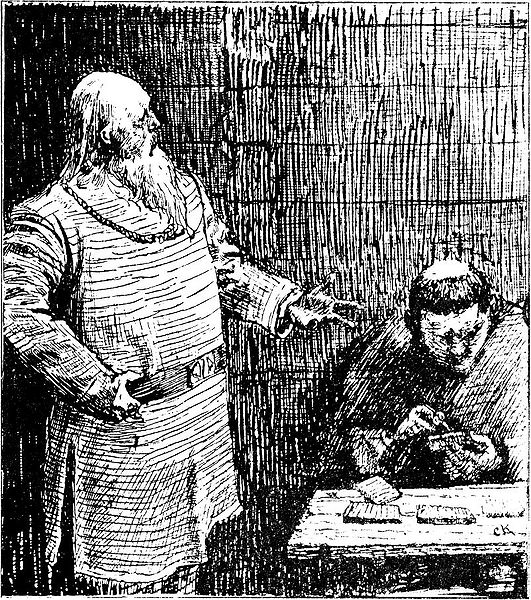A skald (lit. "poet") has historically been used to refer to the poets and authors who composed at the courts of Scandinavian leaders during the Viking Age (783-1066 CE), revived in the Middle Ages (600-1600 CE). Skaldic poetry was primarily responsible for sagas, which were primarily written in prose interspersed with poetry or stanzas, while Eddas were written in alliterative verse and passed primarily through oral traditions.
Skaldic poetry has been traced to Bragi Boddason and his Ragnarsdrápa, as this is the earliest collection of skaldic poetry that has survived to modern day. As time went on, skalds rose in their prominence as they codified and shared the largely oral histories of their peoples. Every ruler wished for a skald, for it was the skald that would commemorate their achievements and ensure their legacy, and power, lived on. Skaldic work nearly became extinct, but was revitalized by Snorri Sturluson's Prose Edda, compiled in the 1100s CE, in which Sturleson defined much of the traditions, literary tools, and records as well as bringing the Edda into skaldic work. Over three hundred skalds have been identified, and active work is being done by the Skaldic Poetry of the Scandinavian Middle Ages Project to both recover previous work and revitalize the art.
Skaldic poetry primarly took one of three forms: drápa, which consisted of a long series of stanzas (typically dróttkvætt) with a refrain (stef) at intervals; Flokkr, vísur or dræplingr, which were shorter series of stanzas without any refrain; or lausavísa, a single long stanza of dróttkvætt, typically considered to have been improvided impromptu for the occasion it marks. Skalds also composed níðvísur (insulting, rude poetry) and mansöngr (erotic verse), though much less frequently.
The primary metre of skaldic poetry is dróttkvætt (lit. "courtly meter"), which utilized interal rhymes and assonance in eight lines, each having three lifts and six syllables in a predominantly trochaic stress pattern; the last two syllables of each line formed a trochee, though there are exceptions). Kenning is a key tool utilized in the literature, in which the skald would use compounded figurative language in place of more concrete nouns; kenning has historically made skaldic verse difficult to understand in the modern day, as the primary meaning of a highly descriptive, figurative phrase may be lost entirely due to change in meaning or translation of a single word.
Skalds have primarily focused on historical and economic subject matter, as they detailed the deeds of their patron in order to secure their position. There is little to no evidence that skalds were minstrels or musicians; rather, skalds primarily functioned with the written word and oral recitation.
Sources:
- "skald". Store norske leksikon.
- Børge Nordbø. "skaldediktning". Store norske leksikon.
- Knut Helle (4 September 2003). The Cambridge History of Scandinavia. Cambridge University Press. pp. 551–. ISBN 978-0-521-47299-9.
- "Dróttkvætt". Skaldic Project Academic Body.
- Wills, Tarrin (2018-08-17). "Skaldic Project: Statistics". Skaldic Poetry of the Scandinavian Middle Ages. Archived from the original on 5 December 2019.
- Wills, Tarrin (2017-07-27). "Skaldic Project - Cross-Platform Interface". Skaldic Poetry of the Scandinavian Middle Ages. Archived from the original on 17 December 2019.
- "Brage Boddason Den Gamle". Norsk biografisk leksikon.
- "Ragnarsdrápa". heimskringla.no
- Christina von Nolcken. "Egil Skallagrimsson and the Viking Ideal". University of Chicago.
- "Torbjørn Hornklove". Norsk biografisk leksikon.
- The Skalds: A Selection of Their Poems, with Introduction and Notes by Lee M. Hollander Review by H. M. Smyser, “Speculum," Vol. 21, No. 2 (Apr. 1946), Medieval Academy of America
- "Snorri Sturluson - Icelandic writer". Encyclopedia Britannica.
- Børge Nordbø. "Snorre Sturlason". Norsk biografisk leksikon.
- Gade, Kari Ellen (1995). The Structure of Old Norse Dróttkvætt Poetry. Cornell University Press. p. 25. ISBN 0801430232.
- Ringler, Dick (ed. and trans.). Jónas Hallgrímsson: Selected Poetry and Prose (1998), ch. III.1.B 'Skaldic Strophes', http://www.library.wisc.edu/etext/jonas/Prosody/Prosody-I.html#Pro.I.B Archived 2013-01-21 at the Wayback Machine
- Clunies Ross, Margaret (2005). A History of Old Norse Poetry and Poetics. D. S. Brewer. ISBN 978-1843842798.




Comments